Ancient Mysteries Of West Virginia: Did Ancient Celts Visit North America Where They Left An Ogham Inscribed Bone Needle With Christian Symbols?
Ellen Lloyd - AncientPages.com - As we continue to explore the ancient mysteries of North America, we come across a very puzzling discovery made in a cave in West Virginia.
It’s a controversial and very intriguing find, that could re-write the history of North America. Who were the mysterious petroglyph people who left behind a puzzling artifact inscribed in Ogham and covered with Christian symbols? Did the ancient unearthed skeleton belong to an unknown European explorer who reached America 800 years before Columbus?
Is there an ancient connection between Ireland and West Virginia we still know nothing about?
Controversial Discovery In A Cave In West Virginia
Our quest for truth takes us back to the year 1989 when archaeologist Robert Pyle discovered remains of a human skeleton in a rock shelter at the Cook petroglyph site in Wyoming County, West Virginia. Pyle who had been exploring the mountains of southern part of the state studying petroglyphs became intrigued with the discovery of this ancient unknown man and wanted to learn more about him.
Pyle had previously found Ogham petroglyphs on an ancient bone needle not far from the site started to wonder if there was any connection between the two discoveries.
Archaeologist Robert Pyle made an astonishing discovery in a cave in West Virginia.
Examination of the bone needle revealed the artifact was etched with Ogham, an ancient Irish alphabet. The bone was very old. Scientists dated it to 2,300 B.C, but the markings on the needle were created sometime around the 5th or 6th century A.D.
Pyle suspected the bone needle had been left by ancient Celts from Ireland. But as we all know, to suspect one thing is easy, but to prove it is much more difficult. Pyle decided to travel to Ireland.
Perhaps the answers to his questions could be found on the Emerald Island (a poetic name for Ireland due to its green countryside). In Ireland, Pyle studied several Ogham artifacts with the guidance of Irish experts. Then, he returned to West Virginia and continued his excavations.
The bone needle created a controversy among scientists and many had doubts the artifact was genuine.
An ancient bone needle etched in Ogham was found in a cave in West Virginia. Image credit: Robert Pyle
The Bone Needle Was A Genuine Ogham Artifact - Experts Said
The artifact was examined by several experts who made plenty of analyses.
After an extensive amount of study, a conclusion was reached – the bone needle was etched in Ogham, an Old World script. Experts in Ogham from the Ireland and University of Maryland stated the artifact was genuine.
According to Dr. William Grant, Edinburgh University, Scotland, and Dr. John Grant, Oakland, Maryland, both Celtic linguists/scholars, who participated in Pyle's Ogham research in southern West Virginia, there was no doubt that the artifact was authentic archaic Ogham.
Nevertheless, many other scholars were not impressed and most simply laughed it off or ignored the controversial artifact, pretending it never existed.
The negative attitude did not discourage archaeologist Pyle. Instead, he became more and more determined to unravel the mystery of the ancient skeleton unearthed in the cave and establish the man’s origin. Pyle continued to study the site and look for clues. Somewhere there must be something that could help him find out what really happened in West Virginia all those years ago.
Did Ancient Celts From Ireland Visit West Virginia?
Pyle was convinced the unearthed ancient skull discovered in 1989 was of an adult male. According to Pyle, it “was sufficiently preserved to recognize a unique brachycephalic (round-headed) feature indicating a possible European origin.” Based on the archaeologist's experience, the condition of the remains indicated a great age.
Of course, Pyle knew, he couldn’t prove anything without laboratory tests.
In 2000, Pyle funding became finally available from a private source and Pyle could find out if his theory was valid. The ancient skull from the cave in West Virginia was examined by experts. Mitochondrial DNA was extracted from the roots of the teeth and compared to previously cataloged DNA sequences from ethnic groups around the world.
Radiocarbon dating conducted on a sample from the established age of the remains at 1,292 +/-40 years old (about the year 710 +/- 40 years AD).
“These combined scientific data from DNA and C14 testing establish the presence of a person of European origin in southern West Virginia around the year 710 AD, the earliest date that a European has been positively identified on the North American continent through scientific data.
There have been numerous theories and extensive controversy for the past two centuries about pre-Columbian visitors to this continent, but no suitable remains have been discovered and available for testing with any conclusive results until now, “ Pyle said.
The closest DNA was as Pyle suspected of European origin, but was the man who died in the cave an ancient Celt? This question remains unanswered.
 The closest DNA was as Pyle suspected of European origin, but was the man who died in the cave an ancient Celt?
The closest DNA was as Pyle suspected of European origin, but was the man who died in the cave an ancient Celt?
We already know that Columbus was not the first to discover America.
In 2016, archaeologists discovered a second Viking site ever found in North America. It’s a truly significant historical find that offers tantalizing evidence of a Viking presence 300 miles from the only place in Canada they’d ever been seen before.
According to scientists examining the area, Point Rosee, the ancient site can be traced to the Vikings. If it was not established by the Vikings, then we are seeing ancient remains of an entirely new culture.
There is also a controversial theory suggesting that ancient Chinese visited North America 2,500 years ago.
Evidence of ancient Celtic activity has not yet been confirmed by scientists, but there are many puzzling archaeological discoveries that indicate Celts did reach North America and even Canada.
There are those who believe the Peterborough petroglyphs could offer evidence ancient Celts visited Canada 2,000 years ago.
New Hampshire Mystery Hill, also known as America’s Stonehenge has puzzled scientists for centuries. The stones and inscriptions discovered at this location offer evidence clearly showing that Columbus was not first person to reach the New World.
Was America’s Stonehenge perhaps built by ancient Celts?
Evidence suggests that North America was colonized long before the birth of Christ. Did an advanced civilization arrive on American shores thousands of years ago? Who were they? Where did they come from?
Written by - Ellen Lloyd – AncientPages.com
Copyright © AncientPages.com All rights reserved. This material may not be published, broadcast, rewritten or redistributed in whole or part without the express written permission of AncientPages.com
Expand for referencesMore From Ancient Pages
-
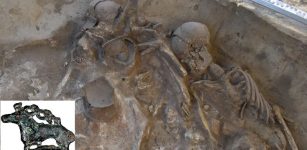 2,000-Year-Old Tumulus Of Unknown Culture Discovered In Siberia – Who Were These People?
Archaeology | Jan 4, 2023
2,000-Year-Old Tumulus Of Unknown Culture Discovered In Siberia – Who Were These People?
Archaeology | Jan 4, 2023 -
 4 Things Ancient Greeks And Romans Got Right About Mental Health
Featured Stories | Aug 30, 2024
4 Things Ancient Greeks And Romans Got Right About Mental Health
Featured Stories | Aug 30, 2024 -
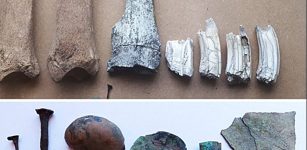 South American Cultures Quickly Adopted Horses – New Study
Archaeology | Dec 26, 2023
South American Cultures Quickly Adopted Horses – New Study
Archaeology | Dec 26, 2023 -
 Surprising Discovery – Large Piece Of Egyptian Blue Found In Domus Aurea, Emperor Nero’s Palace
Archaeology | Feb 11, 2025
Surprising Discovery – Large Piece Of Egyptian Blue Found In Domus Aurea, Emperor Nero’s Palace
Archaeology | Feb 11, 2025 -
 Chickens Were Introduced To Britain, Mainland Europe, And Northern Africa Later Than Previously Thought
Archaeology | Jun 13, 2022
Chickens Were Introduced To Britain, Mainland Europe, And Northern Africa Later Than Previously Thought
Archaeology | Jun 13, 2022 -
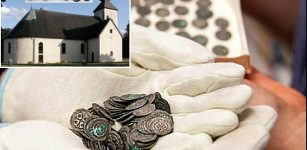 Trove Of Coins Dating Back To The 1100s Found On Visingsö, Sweden
Archaeology | Apr 8, 2024
Trove Of Coins Dating Back To The 1100s Found On Visingsö, Sweden
Archaeology | Apr 8, 2024 -
 Complete Neolithic Cursus Discovered On Isle of Arran, Scotland
Archaeology | Sep 7, 2023
Complete Neolithic Cursus Discovered On Isle of Arran, Scotland
Archaeology | Sep 7, 2023 -
 Secret Ancient Subterranean Tunnels And Caverns Across America: Who Or What Were Our Ancestors Hiding From?
Ancient Mysteries | Oct 4, 2015
Secret Ancient Subterranean Tunnels And Caverns Across America: Who Or What Were Our Ancestors Hiding From?
Ancient Mysteries | Oct 4, 2015 -
 Mysterious Kofun – Ancient Japanese Tombs Were Aligned Towards The Rising Sun And Goddess Amaterasu – Satellite Images Reveal
Archaeology | Jan 20, 2022
Mysterious Kofun – Ancient Japanese Tombs Were Aligned Towards The Rising Sun And Goddess Amaterasu – Satellite Images Reveal
Archaeology | Jan 20, 2022 -
 Neanderthal Genes Influence Your Mood And Much More – Study Shows
Archaeology | Oct 6, 2017
Neanderthal Genes Influence Your Mood And Much More – Study Shows
Archaeology | Oct 6, 2017 -
 Neanderthals Changed Ecosystems 125,000 Years Ago
Archaeology | Dec 16, 2021
Neanderthals Changed Ecosystems 125,000 Years Ago
Archaeology | Dec 16, 2021 -
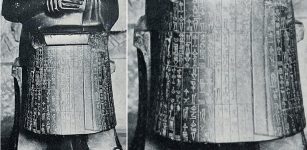 Statue Of Gudea: The King-Priest Of Sumerian City Of Lagash In Southeast Mesopotamia
Featured Stories | Aug 14, 2016
Statue Of Gudea: The King-Priest Of Sumerian City Of Lagash In Southeast Mesopotamia
Featured Stories | Aug 14, 2016 -
 Home Of The Gods – Ancient Cities, Underground Worlds, Incredible Technology And Date Of Departure – Part 2
Ancient Mysteries | Jun 13, 2018
Home Of The Gods – Ancient Cities, Underground Worlds, Incredible Technology And Date Of Departure – Part 2
Ancient Mysteries | Jun 13, 2018 -
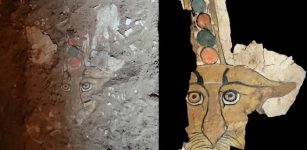 Rare Ancient Leopard Painting Discovered On Sarcophagus In Aswan, Egypt
Archaeology | Feb 25, 2020
Rare Ancient Leopard Painting Discovered On Sarcophagus In Aswan, Egypt
Archaeology | Feb 25, 2020 -
 House Of Plantagenet – How Hatred, Revenge And Jealousy Transformed History
Featured Stories | Jul 27, 2018
House Of Plantagenet – How Hatred, Revenge And Jealousy Transformed History
Featured Stories | Jul 27, 2018 -
 Four Roman-Era Brooches And A Ring Found In The Borki Forest, Poland
Archaeology | Mar 15, 2024
Four Roman-Era Brooches And A Ring Found In The Borki Forest, Poland
Archaeology | Mar 15, 2024 -
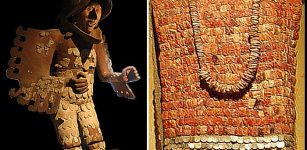 Fearsome Aztec Eagle And Jaguar Warriors Of Mesoamerica
Featured Stories | Sep 14, 2023
Fearsome Aztec Eagle And Jaguar Warriors Of Mesoamerica
Featured Stories | Sep 14, 2023 -
 Mysterious Cucuteni-Tyrpillian Culture Burned Their Settlements For Unknown Reasons
Civilizations | Feb 12, 2021
Mysterious Cucuteni-Tyrpillian Culture Burned Their Settlements For Unknown Reasons
Civilizations | Feb 12, 2021 -
 Battle Of Visby – Death Came With King Atterdag’s Ships
Featured Stories | Jul 27, 2022
Battle Of Visby – Death Came With King Atterdag’s Ships
Featured Stories | Jul 27, 2022 -
 Legendary Erlang Shen And His Third Seeing Eye That Could Distinguish Between Truth And Lie
Chinese Mythology | Aug 14, 2018
Legendary Erlang Shen And His Third Seeing Eye That Could Distinguish Between Truth And Lie
Chinese Mythology | Aug 14, 2018





